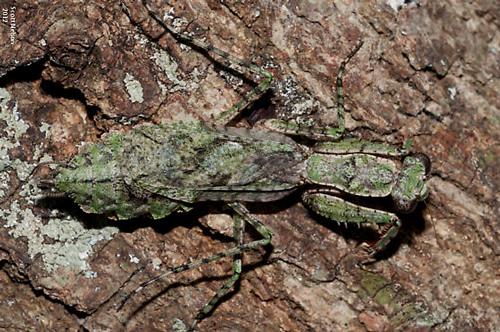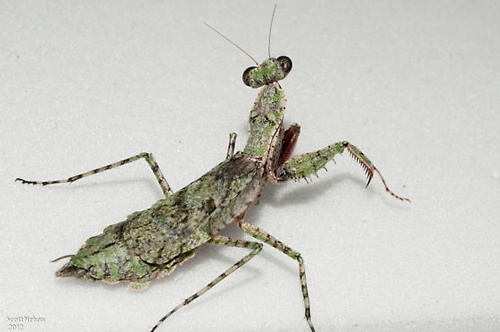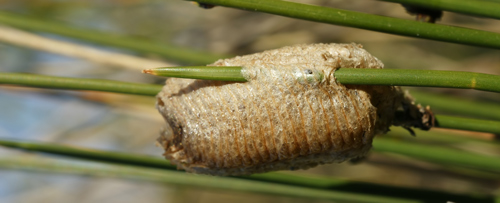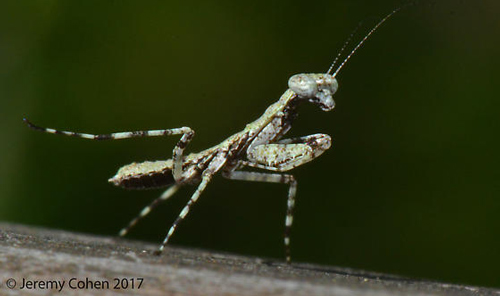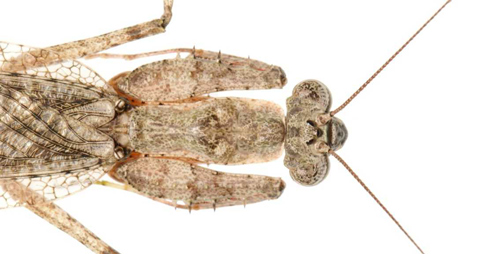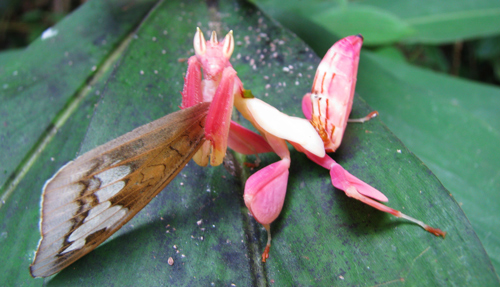common name: grizzled mantid (suggested common name)
scientific name: Gonatista grisea (Fabricius) (Mantodea: Mantidae)
Introduction - Distribution - Description - Life Cycle - Behavior - Host plants - Captivity - Selected References
Introduction (Back to Top)
The grizzled mantid, Gonatista grisea (Fabricius) (Figure 1), is an arboreal (tree dwelling) mantid commonly found in Florida. It is a mottled gray-green in color and somewhat flattened, which allows it to mimic lichens while pressed against tree trunks (Krombein 1963). Grizzled mantids are predators of other arthropods.
Figure 1. Adult Gonatista grisea (Fabricius) on a tree trunk. Photograph by Scott D. Nelson, Lutheran School Educator.
Distribution (Back to Top)
Gonatista grisea are found in the United States from southern Florida northward to Georgia and South Carolina, as well as in Puerto Rico. They are also found in Cuba and Jamaica (Agudelo et al. 2007, Patel et al. 2016). According to Blatchley (1920), a specimen was recorded in Texas, but that report may not represent the mantid's true range.
Description (Back to Top)
The adult grizzled mantid has a short body, 36 to 38 mm for adult males and 37 to 40 mm for adult females, with the males having more slender bodies than the females (Blatchley 1920). They are a grayish-green color, and mottled with dark markings allowing them to appear camouflaged with lichens (Figure 2). Their triangular-shaped head has large, prominent eyes, ocelli (larger in males than females), and antennae that are less than half the length of the body. The raptorial forelegs of grizzled mantids are stout, usually with five or six spines, as seen in Figure 2 (Blatchley 1920). An identification key for the recorded mantids of Florida can be found here.
Figure 2. Adult Gonatista grisea (Fabricius) showing spines on the raptorial forelegs. Photograph by Scott D. Nelson, Lutheran School Educator.
Life Cycle (Back to Top)
Mantid eggs are laid in the fall and are enclosed in a case called an ootheca (Figure 3), where the eggs overwinter. When the ootheca is produced it consists of a soft foam but then hardens and turns brittle. A single ootheca can contain over 200 eggs (Triplehorn and Johnson 2005). Mantids develop through simple metamorphosis (hemimetabolism), meaning they progress from egg to nymph and nymph to adult with the nymphs being smaller, wingless versions of the adult (Figure 4). The nymphs of many species molt through seven instars before emerging as winged adults (Matsura et al. 1975, Hurd and Eisenberg 1984). After mating, female mantids of some species have been known to cannibalize their mate, a behavior known as sexual cannibalism (Lawrence 1992). One hypothesis for this is that the females may be feeding on their mates in order to acquire nutrients. These added nutrients could result in more eggs being laid (Birkhead et al. 1988). In the wild, most mantid species typically live about one year.
Figure 3. Mantid (Mantodea) ootheca (egg case) of an unknown species on a plant. Photograph by Hans Hillewaert.
Figure 4. Grizzled mantid, Gonatista grisea (Fabricius), nymph. Photograph by Jeremy Cohen, University of South Florida.
Behavior (Back to Top)
The grizzled mantid is quick, and has a fast, scuttling movement when disturbed, opposite of the direction from which the disruption occurs (Blatchley 1920, Krombein 1963). It feeds exclusively on arthropods, capturing prey with an ambush method (Ladau 2003). When resting, the grizzled mantid (both adults and nymphs) presses tightly to the bark of the surface it is on, with its head facing downwards. In this position, the forelegs fold tightly against the pronotum of the mantid (Figure 5) (Rehn and Hebard 1904, Blatchley 1920, Krombein 1963, Ladau 2003). At times when the mantid is not resting, it repositions slightly into more of an ambush position for capturing prey. In this position, the front half of its body and legs raise off the surface slightly (Krombein 1963). A study by Ladau (2003) tested the directionality of the mantid in relation to prey capture and found that although the mantids preferred to be facing downwards, they were able to catch prey just as efficiently in every direction. Because of this, Ladau (2003) hypothesized the mantid faces downward to increase the number of prey it catches, as many of its prey species would be more likely to be moving up the tree trunk from the ground below.
Figure 5. Adult grizzled mantid, Gonatista grisea (Fabricius), resting with forelegs tight against the pronotum. Photograph by Lawrence Reeves, University of Florida.
Host Plants(Back to Top)
Grizzled mantid adults and/or nymphs have been recorded resting on the following plant species:
Hicoria floridana (small scrub hickory), Bursera simaruba (gumbo-limbo), Roystonea regia (royal palm), Coccoloba uvifera (sea grape), Quercus nigra (water oak), and a Magnolia spp. (Rehn and Hebard 1904, Blatchley 1920, Krombein 1963, Peck and Beninger 1989). It is extremely likely these mantids rest on many more tree species than have been recorded and listed here. For example, they have been seen with great frequency in Florida olive (Olea europaea) groves during recent pest surveys (Gillett-Kaufman, personal observation). Almost all accounts of this mantid were from the trunks of the trees where they are most easily camouflaged. Blending in with the tree trunks can serve as protection from possible predators, such as birds (Ladau 2003).
Captivity (Back to Top)
Mantids are becoming popular as low maintenance pets. Informational pages on mantid rearing and care like this one from the University of Florida can be found online. Some people keep mantids by collecting egg cases, others purchase late instar nymphs. When keeping egg cases, the mantids must either be separated or provided ample food once they hatch, as they become cannibalistic and the larger nymphs will feed on the smaller nymphs (Hurd and Eisenberg 1984, Triplehorn and Johnson 2005). Mantids require live prey, which can be caught or purchased from a pet store (Day 2009). As they grow and become accustomed to captivity, the mantids will eventually take food from the owner’s hand (Olney 1978).
When purchasing a mantid as a pet, there are often exotic species available online and in shops. There are mantids such as the Chinese mantid and Carolina mantid, both of which can be found in the wild in parts of the United States. Other potential choices are the spiny flower mantid or the orchid mantid (Figure 6). It is critical to be reminded that mantids purchased as pets should never be released into the wild. In Florida, if you want to own a mantid that is not native to the state, you must obtain a permit from the Florida Department of Agriculture and Consumer Services. More information can be found here. Mantids that are native to the state of Florida do not require a permit to be kept here as pets. If you reside in a state other than Florida, you should check your state's requirements.
Figure 6. The orchid mantid, Hymenopus coronatus, an exotic pet mantid species. Photograph by Pavel Kirillov.
Selected References (Back to Top)
- Agudelo AA, Lombardo F, Jantsch LJ. 2007. Checklist of the Neotropical mantids (Insecta, Dictyoptera, Mantodea). Biota Colombiana 8: 105-158.
- Birkhead TR, Lee KE, Young P. 1988. Sexual cannibalism in a praying mantid, Hierodula membranacea. Behaviour 106: 112-118.
- Blatchley WS. 1920. Orthoptera of Northeastern America with especial reference to the faunas of Indiana and Florida. The Nature Publishing Company, Indianapolis.
- Day T. 2009. Pets parents hate: Animal life cycles. Capstone Press.
- Herd LE, Eisenberg RM. 1984. Experimental density manipulations of the predator Tenodera sinensis (Orthoptera: Mantidae), in an old field community. Mortality, development, and dispersal of juvenile mantids. Journal of Animal Ecology 53: 269-281.
- Krombein KV. 1963. Behavioral notes on the Floridian mantid, Gonatista grisea (F.) (Orthoptera, Mantidae). Entomological News 74: 1-2.
- Ladau J. 2003. Prey capture in a mantid (Gonatista grisea): Does geotropy promote success? Canadian Journal of Zoology 81: 354-356.
- Lawrence SE. 1992. Sexual cannibalism in the praying mantid, Mantis religiosa: A field study. Animal Behavior 43: 569-583.
- Matsura T, Inoue T, Hosomi Y. 1975. Ecological studies of a mantid, Paratenodera angustipennis de Saussure I. Evaluation of the feeding condition in natural habits. Researches on Population Ecology 17: 64-76.
- Olney RR. 1978. Keeping insects as pets. Franklin Watts Publishing.
- Patel S, Singh G, Singh R. 2016. A checklist of global distribution of Liturgusidae and Thespidae (Mantodea: Dictyoptera). Journal of Entomology and Zoology Studies 4: 793-803.
- Peck SB, Beninger C. 1989. A survey of insects of the Florida Keys: Cockroaches (Blattodea), mantids (Mantodea), and walkingsticks (Phasmatodea). Florida Entomologist 72: 612-617.
- Rehn JA, Hebard M. 1904. The Orthoptera of Thomas County, Georgia, and Leon County, Florida. Proceedings of the Academy of Natural Sciences of Philadelphia 56: 774-802.
- Triplehorn CA, Johnson NF. 2005. Borror and Delong's Introduction to the study of insects. Thomson Brooks/Cole, Belmont, CA.
